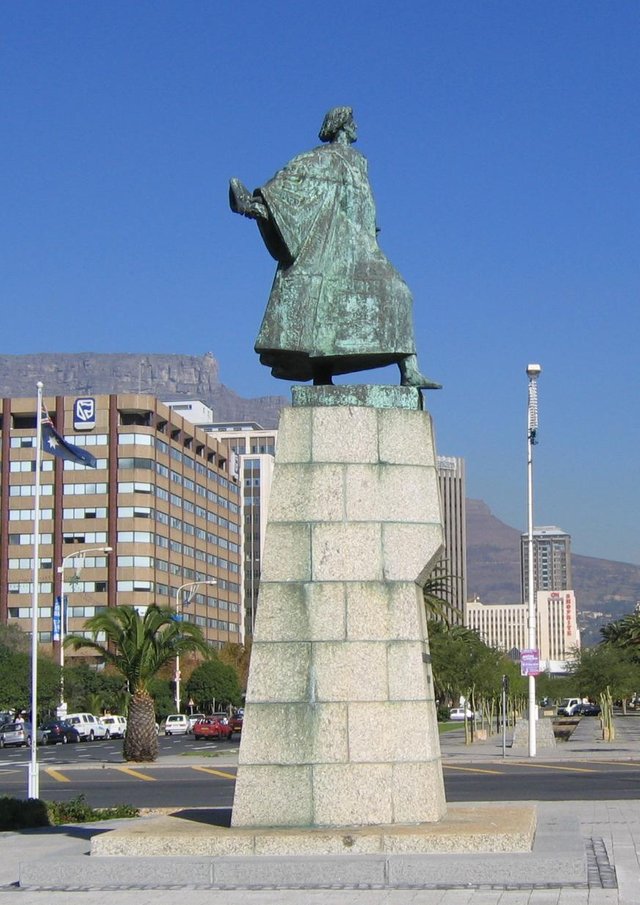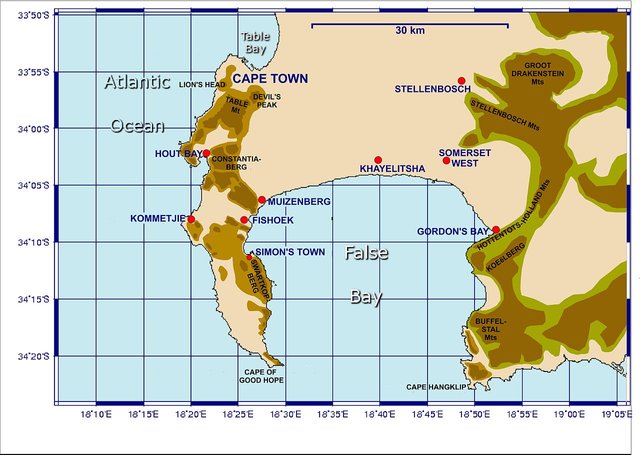Bartolomeu Dias: Going Home
Bartolomeu Dias was the first European to round the African continent and sail into the Indian Ocean. He landed in South Africa and interacted with the local hunter-gathers. After doing so, however, what happened to him and what is his legacy?

Statue of Bartolomeu Dias, Cape Town, South Africa
In a previous post, I described Bartolomeu Dias's first voyage around the African continent, leading up to the erection of what is today known as Diaz Cross. In a follow-up post the intriguing legend of Prester John was examined, since finding a router to his Christian kingdom in Africa was the ultimate quest.
We left the story at the point where his exhausted and frightened crew had forced Dias to turn back to Portugal. On March 12th 1488, shortly after turning back, he erected his most easterly cross which he named the padrão de São Gregorio.
The journey home
Once again, the squadron of three ships sailed into Algoa Bay where they had spent some time a few months before. They anchored at Struisbaai Bay on 23 April, naming it Aguada de San Jorgy. They stayed there for a while stocking up on fresh food. They reached Cape Agualus on May 16th - not realising that this was the most southern point of the African continent.
I have sailed past Cape Agualus and so cannot blame Dias, nor the many navigators who came after him, in not recognising its geographical significance - it has no interesting features and is most unimpressive. So little did he know that he was crossing back into the Atlantic Ocean at this point.
The ships sailed on into Walker Bay, a beautiful stretch of coastline backed by magnificent mountain ranges. It is well known as a the breeding grounds of Southern Right whales, but it's unlikely that they would have posed a danger to the fleet since the whales congregate there between June and December every year.
Rounding Cape Hangklip and entering False Bay (naming it Golfo dentro das Serras), Dias must have caught his first glimpse of Table Mountain. (Remember that on the outward leg of the voyage, they were blown south-west and never saw the Cape Peninsula, only making landfall hundreds of miles to the east.)
On June 6th, Dias erected a second cross (padrão) somewhere on the Cape Peninsula. It was dedicated to São Filipe (June 6th is Saint Philip's Day). No trace of this cross has ever been found.
Interestingly enough, on the very day that Dias reached the Cape of Good Hope, Christopher Columbus embarked on his journey across the Atlantic, looking for a route to India.
What's it called?
There is some controversy about the naming of the Cape Peninsula. From that time it was known as both Cabo Tormentosa (Cape of Storms, a name sometimes still used today) and Cabo da Boa Esperança (Cape of Good Hope). Legend has it that Dias called it Cabo Tormentosa and that King John II of Portugal renamed it Cabo da Boa Esperança. But a note found in Christopher Columbus's records gave an account to the King that Dias had recounted how he had navigated Cabo da Boa Esperanca. This makes sense since Dias must have realised that by finding the passage around the Cape, there would be great hope in discovering the route to India.
Today the Cape peninsula is officially named the Cape of Good Hope.
Back home
The trip back to Portugal was not without incident. On the way down, they had left their supply ship at a place they called Angra do Salto (probably in modern Angola), guarded by nine men. But when they returned there, only three of the men had survived repeated attacks by the locals - with a seventh dying on the journey home.
Dias arrived back in his home port at the river Tagus in December 1488. The voyage has lasted sixteen months and seventeen days. He had charted every league of the previously unknown coastline - all 350 leagues of it. Unfortunately, the chart was lost.
The returning mariners were met by triumphant crowds. But that wasn't good enough for the king. Dias had not found a route to Prester John's kingdom and had not met up with the two explorers the king had sent to search for it, Afonso de Paiva and Pêro da Covilhã. So for all his immense achievements, he was never put in a position of authority again.
The final years
King João’s successor, Manuel I took a keen interest in exploration and Vasco da Gama would lead many expeditions. It took nine years for the next fleet to sail around Africa in search of India. Dias sailed with the da Gama expedition as far as the Cape Verde Islands, then returned to Guinea.
Nine years were to elapse before the next Portuguese fleet under Vasco da Gama sailed around Africa in search of India. Dias accompanied Da Gama's fleet as far as the Cape Verde islands where he left it to command the fort at Mina. Dias gained experience in trading at Mina and brought back with him a cargo of gold and slaves, which were sold to provide finances for further expeditions.
The success of da Gama's voyage made King Manuel determined to send a strong armada to take advantage of these discoveries. Dias commanded four of the ships. They sailed south towards Brasil to take advantage of the trade winds. On March 9th 1500, the fleet reached Brazil and on May 2nd set out again and turned south-westward towards Cabo da Boa Esperança, the Cape of Good Hope.
Near the feared Cabo Tormentosa , the fleet was overwhelmed by a massive storm - probably a cyclone - and four ships sank with all crew.
Among them was Bartolomeu Dias.
He never made it to India. But he did round the southern tip of Africa showing that a sea trade route to India - and by extension the rest of Asia - was possible. The knowledge he brought from his discoveries enabled future explorers and merchants to open up world trade, bringing immense wealth to the European trading countries. Sadly, in many cases, this was accompanied by centuries of misery through colonialism and exploitation.
Previous posts in this series:
https://steemit.com/history/@tim-beck/dias-cross-a-monument-to-a-great-explorer
https://steemit.com/history/@tim-beck/where-in-the-world-is-prester-john
References:
https://www.history.com/topics/exploration/bartolomeu-dias
https://exploration.marinersmuseum.org/subject/bartolomeu-dias/
https://www.sahistory.org.za/people/bartolomeu-dias
Also posted on Weku, @tim-beck, 2018-10-28
